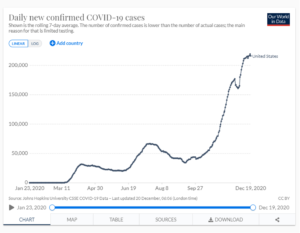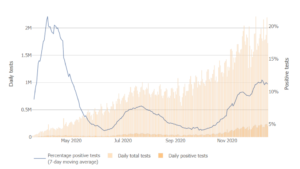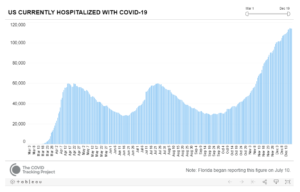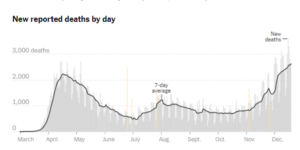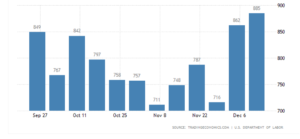Dr. Anthony Fauci confirms he vaccinated Santa for COVID-19
Santa, Please Bring the Vaccine
When I was a kid, I remember looking forward eagerly to Christmas. I had dreams of what Santa would bring to our home. I remember wishing for a bike, a catcher’s mitt, and outdoor knife. My brother and I would leave holiday cookies (which my mom made) for Santa. I remember getting up on Christmas Eve, opening the curtains in my bedroom and peering into the sky for that shiny red nose. Thankfully, the reindeer always found our house, the cookies were always taken, and our wishes were almost always granted.
As we approach Christmas, my wish is that Americans will get vaccinated as quickly possible, that we will achieve “herd immunity,” and that we can put COVID-19 behind us.
The Biden Administration Approaches
Last week in state capitals across the 50 states, the Electoral College granted Joe Biden 306 votes, thus assuring him of victory in the 2020 presidential election. On January 6, the results of the Electoral College will be ratified by a joint session of Congress. Biden will be sworn in as the nation’s 46th President on January 20, 2021 on the West Front of the United States Capitol.
The Markets
The stock market continues to ignore the pandemic that is raging across the nation. All the major indices set new highs last week.
On Friday, the Dow Jones Industrial Average was down 124 points, or 0.41%. The S&P 500 index fell 13 points, or 0.35%. The Nasdaq decreased 9 points, or 0.07%. For the week, the Dow advanced 0.4%, the S&P 500 index rose 1.3% and the Nasdaq added 3.1%.
The yield on the 10-year Treasury Note was up slightly to 0.945% on Friday. Spot gold traded at $1,887 on Friday and is up 21% for the year. West Texas Intermediate Crude futures for January 2021 delivery traded at $49.08 a barrel. Oil has rallied the past few months but remains down 13% in 2020.
COVID-19
Globally, across 213 countries and territories, there have been nearly 77 million confirmed cases and nearly 1.7 million deaths. In the United States, nearly 18 million have been infected and over 317,000 have died.
Infections
COVID-19 continues to infiltrate the country. Infections are at all-time highs as depicted in the following image. The number of new cases per day has been in excess of 200,000 for two weeks.
Source: https://ourworldindata.org/coronavirus/country/united-states?country=~USA
The positive test rate remains far above the level experienced during the summer.
Source: Johns Hopkins University
https://coronavirus.jhu.edu/testing/individual-states
Hospitalizations
The virus is threatening to overwhelm our health care system. There now well over 100,000 people hospitalized with the virus.
Source: https://covidtracking.com/data/charts/us-currently-hospitalized
While hospitals were better prepared for this surge in infections, they are still confronting staffing shortages, medical supply deficiencies and bed capacity constraints.
Deaths
We are losing a staggering number of our citizens to this virus. The image below shows the daily death count.
Source: https://www.nytimes.com/interactive/2020/us/coronavirus-us-cases.html
The Institute for Health Metrics and Evaluation (IHME) at the University of Washington projects that at total of between 500,000 and 715,000 American will die from the virus by April 1, 202. The variance is driven by mask usage, vaccinations and other containment strategies.
Summary
If you want to see this data since March 1:
Source: https://covidtracking.com/data
Pandemic Fatigue & Noncompliance
We are in this pitched battle with this virus, because we haven’t been able to implement the measures necessary to slow and contain its spread. Health authorities have asked us to wash our hands frequently, wear a mask, avoid crowds, stay at home when possible, limit the size of gatherings, maintain physical distance when near others and other preventative measures.
Yet too many people are flouting these health safety recommendations. Consequently, the virus continues to spread at an alarming rate.
We are not alone in our misbehavior. Many other countries find themselves in similar predicaments.
Vaccines
The first vaccine approved by the Food & Drugs Administration (FDA) for emergency use authorization for COVID-19 entered distribution across the country last week. The vaccine, develop by Pfizer and its partner, BioNTech SE of Germany, is 95% effective against COVID-19. The first person to be officially vaccinated in the US was Sandra Lindsay, a critical care nurse. She received the first of two shots on Monday, December 14, at Long Island Jewish Medical Center in Queens, New York.
Pfizer is manufacturing its drug in Michigan and planned to have 2.9 million doses delivered to more than 1,000 locations across the country by the end of this past weekend.
There was additional good news last week with the approval of another highly effective vaccine developed by Moderna and the National Institutes of Health. The FDA gave emergency authorization for this vaccine, which is 94.1% effective, on December 17 after a recommendation from the Vaccines and Related Biological Products Advisory Committee. Moderna plans to ship 20 million doses to nearly 3,300 sites by the end of the year. It expects to have 85 to 100 million doses available in the US in the first quarter of 2021.
In another interesting development, we learned that the Moderna vaccine can reduce infections that do not cause symptoms. This could mean the vaccine curbs transmission of the virus from person to person. Asymptomatic transmission is a major problem with COVID-19 and preventing it could hasten the end of the pandemic, if enough people get vaccinated. Studies of this possibility continue.
So, we have two highly effective vaccines in distribution under the federal government’s Operation Warp Speed. This is the largest vaccination effort in US history and it presents significant logistical challenges. It should, however, result in the vaccination of 20 million Americans (each receiving two shots) before year end. The U.S. government has agreed pay Pfizer and BioNTech nearly $2 billion for 100 million doses. It will pay Moderna $1.5 billion for 100 million doses of its vaccine and it has an option to purchase an additional 400 million doses.
Who Gets the Vaccine?
The government, following the advice of numerous advisory bodies, has indicated that health care workers and residents of long-term care facilities will be the first to receive the vaccine. Next in line will be essential workers and the elderly. The general public should be able to receive a vaccine in the spring or summer of next year.
The Department of Health and Human Services has indicated that, under Operation Warp Speed, it intends to produce and deliver 300 million doses of safe and effective vaccines.
Who Will Take the Vaccine?
Now that vaccines are on the way, another hurdle will be acceptance. National polling continues to indicate that many Americans are unwilling to take a vaccine for COVID-19. According to a Gallup poll, 63% of American would be willing to receive an FDA-approved vaccine for COVID-19. Some people doubt the seriousness of the virus. Others believe the vaccine is more dangerous than the virus. There is also mistrust among minority groups due to the government’s history of unethical medical experiment and procedures.
We need to get at least 70% of the population vaccinated to effectively contain the virus through herd immunity. The government is fully aware of the reluctance to take the vaccine shots. We can look for the US Department of Health and Human Services to launch a national education campaign to convince hesitant Americans of the benefits of the vaccine. In addition, the AD Council will run a $50 million communications campaign informing the public about COVID-19 vaccines and countering hesitancy.
At home Testing
The FDA has authorized a COVID-19 test that can be administered and processed at home. The test was developed Ellume USA LLC, an Australian company, which received $30 million from the US federal government through the Rapid Acceleration of Diagnostics Initiative at the National Institute of Health. The test is available over the counter, without a prescription. It is a single use, disposable test that produces results in 15 minutes. The test is expected to cost $30 per use and it requires a smartphone to conduct it. The test is 90% accurate.
The Labor Market
COVID-19 continues to disrupt the job market. The number of Americans applying for unemployment benefits increased 885,000 week ending December 12, the highest level since September.
Source: https://tradingeconomics.com/united-states/jobless-claims
Before the pandemic hit last spring, unemployment claims each week averaged around 225,000.
A total of 20.6 million people are now receiving some kind of unemployment benefits. Continuing claims fell to 5.5 million in the week ended December 5 from 5.8 million a week earlier according to the Labor Department. Some of these workers have found jobs. Some have dropped out of the workforce. But the majority have exhausted their state benefits which expire typically after six months.
Congress passed the Pandemic Unemployment Assistance program in March to provide extended benefits to workers. There were 4.8 million people receiving these benefits as of November 28, up from 4.5 million from the prior week. The program also covers gig workers and others who do not qualify for traditional benefits. The number of people receiving such benefits surged to 9.2 million from 8.6 million for the week that ended November 28.
The pace of job creation has slowed. From 4.8 million jobs added in June to 1.8 million in July, 1.5 million in August, 711,000 in September, 610,000 in October and 245,000 in November.
Evictions Loom
Millions of Americans who rent are facing eviction. Earlier this year the Centers for Disease Control and Prevention imposed a ban on evictions under Public Health Service Act who allows the federal government to enact regulations that help stop the spread of disease. The moratorium protects tenants who have missed monthly payments if they declare financial hardship. However, it expires at the end of the year. States and cities have their own eviction bans with varying rules and expiration dates.
Between 2.4 million and 5 million American households are at risk of eviction in January. Millions more are at risk later in the year. Once evicted, renters are still liable for months of unpaid rent. Moody’s Analytics estimates US tenants owe as much as $70 billion in back rent by year-end.
The government will need to step in to address this looming crisis. Evictions which often result dislocation and homelessness are associated with impaired health, disease transmission and death.
The Federal Reserve
Last week at its last policy meeting of 2020, the Federal Reserve indicated that is expects the nation’s economy to rebound as vaccines become widely distributed. However, the Fed anticipates the next thee to six months will be difficult for the millions of Americans who are unemployed and tens of thousands of small businesses which have been disrupted or shuttered by the virus.
The central bank is prepared to keep interests near zero for as long as necessary to support the economy’s recovery. The Fed’s projections suggest interest rates will remain where they are for at least three more years. Barring surprising developments, we can expect inflation to run below 2% for several years.
In addition, Federal Reserve Chairman Jay Powell said, “the case for fiscal policy right now is very, very strong.” Which brings us to the latest development which occurred Sunday evening
Federal Economic Relief
After months of wrangling, Congress finally reached an agreement on a $900 billion coronavirus relief package. The deal will provide a $600 direct payment to many Americans, $300 a week (for 11 weeks) in enhanced federal unemployment benefits, and money for schools, vaccine distribution and small businesses.
Left out of the agreement were funding for state and local governments and liability protection for businesses, schools and other entities.
The votes to pass the legislation should happen in the House and Senate today. The President is expected to sign the bill immediately.
Santa’s On His Way
Dr. Anthony Fauci, Director of the National Institute of Allergy and Infectious Diseases and one of the government’s leading authority on the pandemic went on CNN last week and told kids across America that he had personally traveled to the North Pole and vaccinated Santa Claus. He claimed, “Santa Claus is good to go.”
So, let’s celebrate Christmas … or Hanukkah or whatever you believe. The vaccine is on its way and that is good news for all of us.
Keep the faith, be safe, and stay healthy.
#wearamask
PLEASE SEE important disclosure information at www.springwaterwealth.com/blog-disclosure/.
